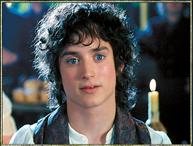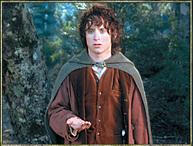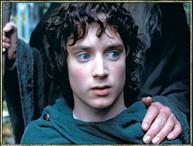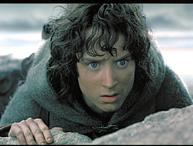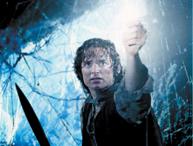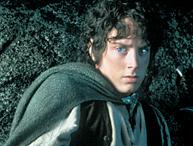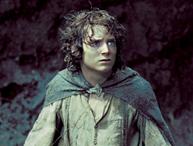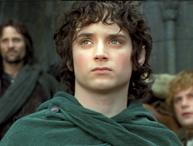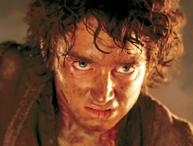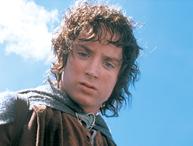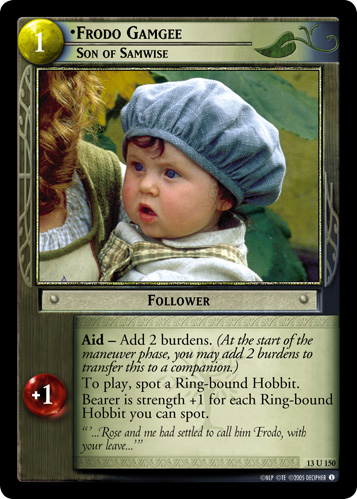|
|
| (46 intermediate revisions by the same user not shown) |
| Line 1: |
Line 1: |
| {{C|Raider}}s are the evil men who live in the domains under Sauron's shadow from the lands to the south and east of Gondor and Rohan. In this game, {{C|Raider}} culture is one of two [[Shadow Alignment|Shadow]] [[culture]]s of evil [[Man|man]] [[minion]]s, and is itself split into three [[subculture]]s: the ambushing, oliphaunt-riding archers of the [[Southron]] Haradrim, the disciplined, ferocious warriors of the [[Easterling]]s, and the larcenous piratical [[Corsair]]s of Umbar. Dark-skinned, evil, stereotypes of vaguely Persian or Turkic invaders who subscribe to an evil foreign religion is not a concept that has aged terribly well, but, hey, playing them means sometimes you get to step on Legolas with a giant war elephant or send an unkempt Peter Jackson to single-handedly crush the entire Fellowship, so you take the good with the bad.
| | Frodo is one of the protagonists of ''The Lord of the Rings'', the [[hobbit]] who steadfastly carries [[the One Ring]] from the Shire to Mount Doom, where it is destroyed by [[Gollum]]. In this game, he is the default [[ring-bearer]] [[companion]], and indeed was the only ring-bearer until [[Reflections|the ninth expansion set]]. Except for his unusually high [[resistance]], his low [[strength]] (3) and relatively high [[vitality]] (4) are typical of hobbits, but generally make him the most vulnerable part of your [[Fellowship]]. |
|
| |
|
| {{C|Raider}} culture as a whole was first introduced in [[The Two Towers]], alongside another, separate faction of evil men, {{C|Dunland}}. Initially, {{C|Raider}}s only included the first two subcultures, Southrons and Easterlings. Both subfactions received more cards and developed over the course of [[Tower Block]], but really came into their own with [[The Return of the King]]. Then [[Siege of Gondor]] introduced [[Corsairs]] and their boats, introducing what would remain a top-tier strategy in [[Movie Block]] to this day.
| | Frodo has a suite of special rules to his name. He's always [[ring-bound]], even if it doesn't say so on his card. Except in the case of {{Card|Frodo, Frenzied Fighter}}, he's always your [[ring-bearer]] if he's in your deck, and thus costs zero [[twilight]]. Until [[Reflections]], he was the only possible [[ring-bearer]] at the start of the game, and (along with [[Sam]]) was one of only two characters with a [[resistance]] score. |
|
| |
|
| All three {{C|Raider}} subcultures were retired after [[King Block]]. The 11th set, [[Shadows]], reorganized and consolidated the Shadow cultures. All of {{C|Raider}} culture was combined with the other evil [[Man|men]] to make {{C|Men}} culture.
| | Because he is almost always your ring-bearer and so vulnerable to being [[overwhelm]]ed in a skirmish, getting the most out of Frodo involves protecting him, ideally keeping him away from [[skirmish]]es altogether. He has [[the One Ring]], but in most cases that is a poor defense against being overwhelmed. [[Swarm|Some decks]] will drag him into a skirmish anyway, however. To make him a bit safer, you can give him something to boost his strength. Permanent buffs include {{Card|Hobbit Sword}}, some version of {{Card|Sting}}, {{Card|A Promise}}, or {{Card|O Elbereth! Gilthoniel!}}. You can also [[pump]] his strength temporarily, especially with {{Card|Merry, Friend to Sam}}, {{Card|Boromir, Son of Denethor}}, or {{Card|Hobbit Intuition}}. You can protect him from being overwhelmed, with cards like {{Card|Bounder}} or {{Card|The Tale of the Great Ring}}. Or, in early formats like [[Fellowship Block]] and [[Towers Standard]], you can simply cancel his skirmish, with cards like {{Card|Hobbit Stealth}}, {{Card|O Elbereth! Gilthoniel!}}, {{Card|Filibert Bolger, Wily Rascal}}, or {{Card|Frodo's Cloak}}. |
|
| |
|
| ==Shared attributes and shared cards==
| | Frodo has three different roles in three different periods of the game. For the first eight sets, you have to play him, but you can [[Skirmish Cancellation|cancel his skirmishes]]. There's no way around it in [[Fellowship Block]], [[Towers Standard]], [[Towers Block]], or [[King Standard]]: you have to find a way to protect Frodo. |
| The entire culture is one culture, but the way it's split into three means that most decks pick a [[subculture]] and stick with it, only using cards from other subcultures to supplement their strategy. In this way, {{C|Raider}} culture resembles {{C|Isengard}}, although the [[Cultural Enforcement|subcultural enforcement]] isn't nearly so strong. Part of the looseness of this subcultural enforcement is that some cards are weakly aligned with one subfaction or another. A card like {{Card|Discovered}} meshes well with the Easterling plan of placing and [[spot]]ting [[burden]]s, but it's a useful tool for all three subcultures.
| |
|
| |
|
| {{C|Raider}}s have powerful but generally expensive [[event]] cards. Case in point, {{Card|Discovered}} is a staple of {{Card|Raider}} decks. That isn't as memorable as the flashy, expensive, and risky cards to unexpectedly remove troublesome companions: {{Card|Whirling Strike}}, {{Card|Red Wrath}}, and {{Card|Fierce in Despair}}. In theory, these three cards are meant to enable a strategy where you use the Southron signature keyword [[Ambush]] to pay for these powerful events, but the most popular Ambush card isn't an Southron card anyway! In practice, they're mostly used to soak up extra twilight from an opponent who has [[flood]]ed, which is common in [[Movie Block]]. This predilection for expensive events also extends to many of their more mundane effects: non-Corsair subcultures have relatively overpriced [[pump]] events, {{Card|On the March}} and {{Card|New Strength Came Now}}. These are rarely played; instead, players tend to use the many {{C|Raider}} utility [[condition]]s like {{Card|Under Foot}}, {{Card|Small Hope}}, and {{Card|Field of the Fallen}} that have pump effects attached to their main effect.
| | == Versions of Frodo == |
| | {{PersonaTable|Frodo}} |
|
| |
|
| Speaking of which, {{C|Raider}}s have powerful support area cards to enable [[cycling]]. {{Card|Under Foot}} is a keystone of [[swarm]]ing strategies (often multicultural or [[rainbow]] strategies like [[Moria Navy]] or [[Stupid Swarm]]). {{Card|Ships of Great Draught}} not only allows you to never have to worry about a [[Hand Clog|hand clogged]] with Shadow cards, but also lets you retrieve a situational card or play a particularly troublesome card over and over again. With the addition of {{Card|Corsair War Galley}}, this can also give you a near-continuous hold on [[Initiative]], needed to enable certain Southron and Corsair strategies.
| | == Cards which mention Frodo by name == |
|
| |
|
| In theory, {{C|Raider}}s also have strong shared possessions that you play on minions, like {{Card|Raider Bow}} and {{Card|Raider Polearm}}. In practice, both of these cards are only common in one single subculture, and neither one is popular in the culture it's styled after! Both of them appear below along with the corresponding decks.
| | ''to-do'' |
|
| |
|
| Most {{C|Raider}} minions are too tightly integrated into their subculture to really work in any deck that isn't devoting significant space to {{C|Raider}} cards. There's one exception: {{Card|Desert Lord}}. He's great for [[exhaust]]ing annoying characters that need to [[exert]] to use their abilities, like {{Card|Legolas, Greenleaf}}, {{Card|Cirdan, the Shipwright}}, and {{Card|Eowyn, Lady of Ithilien}}. You can just slam him down, get two [[direct wound]]s out of him, and maybe even get a third one when he goes to [[skirmish]]. He's just a really great value card that fits into a variety of decks.
| | == See Also == |
| | * {{Card|Frodo Gamgee, Son of Samwise}} |
|
| |
|
| ==Southrons==
| | [[Category:Unique Characters]] |
| ''See also: [[Southron]]''
| |
| | |
| Southrons have turbans and bows and they're sneaky ambushing desert warriors but also they have oliphaunts. I guess they're sneaky giant war elephants. Southrons want to have lots of [[twilight]] sloshing around after the [[Shadow Phase]] to pay for expensive events and minion abilities. They also want to have [[initiative]], they like to generate and spot and consume [[threat]]s, and occasionally they [[Site Capture|capture sites]]. They also notably dislike overly large or [[rainbow|multicultural]] [[Fellowship]]s. Their subcultural enforcement is sometimes tricky: if a card mentions "a {{CultureIcon|Raider}} archer" or "a mounted {{CultureIcon|Raider}} Man" then it's a card for Southrons, since they have (almost) all of the {{C|Raider}} archers and all of the {{C|Raider}} mounts. They have three sets of basic tools plus some utility cards that appear in a variety of Southron decks, and these come together to make about three common decks.
| |
| | |
| Those decks have a shared toolbox. Southrons love to have a bunch of [[threat]]s sloshing around, and {{Card|Rallying Call}} or {{Card|War Towers}} can generate those threats cheaply. These threats can be turned into wounds by killing a companion, or used to fund cards like {{Card|Southron Marksmen}} or {{Card|Ships of Great Draught}}. {{Card|High Vantage}} can efficiently stymie many wounding strategies. They also have some above-average [[hate]] cards for [[Rule of 6|overly large]] or [[rainbow]] Fellowships, such as {{Card|Southron Leader}}, {{Card|Southron Commander}}, and {{Card|Southron Veterans}}. All of these cards are fairly situational, but that's fine! As long as you have {{Card|Ships of Great Draught}}, you can pitch them into discard easily, or retrieve them later at your convenience.
| |
| | |
| The least important part of Southrons is their signature keyword: '''[[Ambush]]'''. '''Ambush''' generates twilight when minions are assigned. In theory, you'd use it to fund the expensive {{C|Raider}} events, or conditions like {{Card|Howl of Harad}} or {{Card|Harsh Tongues}}. In practice, the Ambush numbers are too small to pay for very much, and the minions with Ambush are largely too weak to be worth bothering with. Insofar as Ambush is used in Southron decks at all, it's largely a little extra on a card that's good enough to use anyway.
| |
| | |
| Southrons also dabble in [[site control]], but their cards for actually controlling sites are so inefficient that they're rarely worth bothering with. The only card of note is {{Card|Southron Archer}}. Southron Archer can be [[splash]]ed into other cultures' site control decks, or [[Movie Block]] decks focusing on Southron archers can use {{Card|City Gates}} as a win-win option.
| |
| | |
| ===Southron direct wounding===
| |
| | |
| The Southron direct wounding deck is two decks, both using very similar strategies. Cards like {{Card|Desert Warrior}} and {{Card|Desert Sneak}} trigger at the beginning of a skirmish, either consuming twilight or looking for [[initiative]] to cause a wound. These two styles of cards form the basis for two different decks.
| |
| | |
| The first deck was mainly known as the "Ambush" or "Howl of Harad" deck. Using mainly [[Tower Block]] cards, it turns a twilight [[flood]] into [[direct wound]]s. {{Card|Desert Warrior}}, {{Card|Desert Spearman}}, and {{Card|Desert Soldier}} turn the twilight from cheap Ambush minions like {{Card|Southron Runner}} or {{Card|Southron Scout}} into direct wounds. {{Card|Southron Assassin}}, {{Card|Howl of Harad}}, and {{Card|Whirling Strike}}. While this is the basis of the Legolas starter deck in [[Battle of Helm's Deep]], it was never a strong or competitive deck. [[King Block]] adds some cards clearly aimed at this strategy, like {{Card|Raider Bow}}, {{Card|Red Wrath}}, and {{Card|Cast Unto the Winds}}, but it never quite comes together.
| |
| | |
| Instead, the successful version of this deck is [[Southron Initiative]], using mainly [[King Block]] cards. {{Card|Desert Sneak}}, {{Card|Desert Runner}}, and sometimes {{Card|Desert Scout}} all wound companions for free when you have [[initiative]], plus they themselves have Ambush to fund the expensive support cards above like {{Card|Howl of Harad}}, {{Card|Whirling Strike}}, or {{Card|Red Wrath}}. {{Card|Southron Invaders}} recycles these super-cheap minions. To get initiative, you can either use {{Card|Corsair War Galley}}. ({{Card|Harsh Tongues}} is too expensive and {{Card|Southron Chieftain}} is too unreliable and easy to kill.) If you're using the Galley, you can just trigger it with {{Card|Ships of Great Draught}}, or run the deck as a hybrid with [[Corsair]]s. Since you have initiative, cheap [[splash]]able cards that exploit initiative like {{Card|Gollum, Plotting Deceiver}} or {{Card|Morgul Lurker}} can be useful.
| |
| | |
| Example deck: [https://lotrtcgwiki.com/forums/index.php/topic,9060.0.html Echo of Luthien/Initiative Southrons], a Movie Block deck by sgtdraino on The Last Homely House forums. This version of the deck is a hybrid with Corsairs, and also runs a bunch of other [[splash]]able minions.
| |
| | |
| ===Southron Archery===
| |
| ''See also: [[Southron Archery]]''
| |
| | |
| Southron archers aren't quite as dirt-cheap as {{Card|Moria}}'s: the cheapest ones are {{Card|Southron Bowman}} and {{Card|Southron Archer}}, followed by {{Card|Elite Archer}}. But, similar to [[Uruk Archery]], they also have archer minions with enough strength to skirmish decently well, with {{Card|Desert Lord}}, {{Card|Haradrim Marksman}}, and {{Card|Southron Marksmen}}. (There are some more-expensive archers that can exploit a heavily flooded twilight pool, but they are overpriced and not popular.) They can also generate threats with {{Card|Rallying Call}}, meaning that once the first companion dies, others will quickly follow. {{Card|Seasoned Leader}} lets minions like {{Card|Desert Lord}} get an extra use of their abilities, and that lends itself naturally to hybridizing this deck with the Southron Mumaks deck below. Alternately, you can just combine this with cheap efficient archers from other cultures, like {{Card|Goblin Bowman}} and {{Card|Morgul Ambusher}}.
| |
| | |
| Example deck: [https://lotrtcgwiki.com/forums/index.php?topic=12034.msg98602#msg98602 Southron archers with boats], a Movie Block deck by Cease on The Last Homely House forums. This is an example of a hybrid using {{Card|Mumak Commander}}.
| |
| | |
| ===Southron Mumaks===
| |
| | |
| {{Card|Mumak Commander}} is just a really strong card. As long as you have a {{Card|Mumak}} in the discard pile, the commander is a 14 [[strength]], 3 [[vitality]] minion with '''[[Fierce]]''' that also generates some twilight. {{Card|Seasoned Leader}} combined with {{Card|Field of the Fallen}} can push that strength up, too. There's even a very dirty [[combo]] where you use Seasoned Leader to recycle {{Card|Ithilien Wilderness}} (or a slightly more-expensive, more-useful card like {{Card|Under Foot}}) in your discard pile over and over, each time turning 1 threat into +2 strength. {{Card|Ships of Great Draught}} will help pitch these cards into the discard pile for you to set up the combos.
| |
| | |
| The issue with this deck is what you do until you get those cards into discard. {{Card|Desert Lord}} and {{Card|Southron Marksmen}} tend to exert themselves, making them very good {{Card|Seasoned Leader}} users, but there really isn't an efficient Southron skirmisher for about 4-6 twilight. As a result, Southron Mumaks are largely a secondary strategy, added onto one of the other two main Southron strategies.
| |
| | |
| ==Easterlings==
| |
| ''See also: [[Easterling]]''
| |
| | |
| Easterlings are disciplined, ferocious warriors. Unlike the Southrons, they have a very straightforward game plan: they want to put at least two [[burden]]s on the [[ring-bearer]], then [[Beatdown|beat the Fellowship down]] with efficient '''[[Fierce]]''' minions. The subculture had the efficient minions from day one, but it didn't really come into its own until [[Return of the King]] added some key cards to easily place the necessary burdens, as well as some [[possession]]s to round things out.
| |
| | |
| The main Easterling deck is a [[King Standard]]/[[Movie Block]] deck: [[Beasterlings]]. The deck uses {{Card|Small Hope}} (and sometimes {{Card|Easterling Footman}}) to place two [[burden]]s quickly and efficiently. The ideal setup is {{Card|Easterling Captain}} [[Bear|bearing]] {{Card|Raider Bow}} to generate twilight for his ability and {{Card|Easterling Polearm}} to protect him from being killed. This can [[overwhelm]] many companions, or generate enough twilight to use {{Card|Red Wrath}} or {{Card|Fierce in Despair}} to deal with the ones you can't. {{Card|Easterling Army}} is somewhat less efficient but can serve the same role or [[pump]] the Captain. {{Card|Easterling Axeman}} is very efficient when you can spot two burdens, but is unlikely to score any [[overwhelm]]s like the other two. {{Card|Ships of Great Draught}} helps set up the combo, {{Card|Easterling Lieutenant}}, {{Card|Vision From Afar}}, and {{Card|New Fear}} can set even more burdens, and {{Card|Ulaire Enquea, Lieutenant of Morgul}} harshly punishes too-large Fellowships or anyone who lets the burden count stack too high.
| |
| | |
| Example decks: [https://lotrtcgwiki.com/forums/index.php?topic=11370 You Must Be Under 5ft to ride this Fellowship/Easterling Burden Beasts] by
| |
| RJH777 and [https://lotrtcgwiki.com/forums/index.php?topic=11370.msg94828#msg94828 an untitled Beasterling deck] by
| |
| mathes further down in the same thread. Both decks are Movie Block decks, originally posted on The Last Homely House forums. RJH777's deck goes wider, focusing more on corruption, while mathes's deck focuses more on scoring overwhelms.
| |
| | |
| Easterlings are also sometimes used as part of a [[Rainbow|multicultural]] [[Corruption]] deck. {{Card|Small Hope}}, {{Card|Easterling Lieutenant}}, {{Card|Vision From Afar}}, and {{Card|New Fear}} all have fairly weak [[cultural enforcement]], only requiring that you spot one Easterling. It's possible to add more corruption tools to an Easterling deck, or add an Easterling contingent to a broader corruption deck to quickly set up a few burdens.
| |
| | |
| ==Corsairs==
| |
| ''See also: [[Corsair]]''
| |
Frodo is one of the protagonists of The Lord of the Rings, the hobbit who steadfastly carries the One Ring from the Shire to Mount Doom, where it is destroyed by Gollum. In this game, he is the default ring-bearer companion, and indeed was the only ring-bearer until the ninth expansion set. Except for his unusually high resistance, his low strength (3) and relatively high vitality (4) are typical of hobbits, but generally make him the most vulnerable part of your Fellowship.
Frodo has a suite of special rules to his name. He's always ring-bound, even if it doesn't say so on his card. Except in the case of Frodo, Frenzied Fighter (13R149)
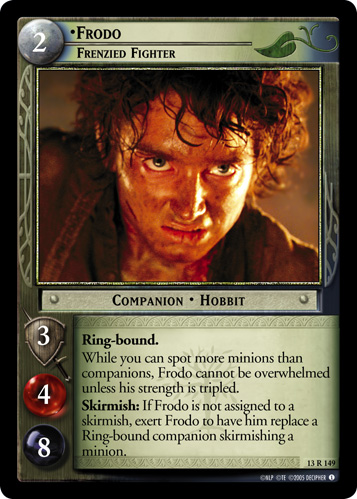 , he's always your ring-bearer if he's in your deck, and thus costs zero twilight. Until Reflections, he was the only possible ring-bearer at the start of the game, and (along with Sam) was one of only two characters with a resistance score.
, he's always your ring-bearer if he's in your deck, and thus costs zero twilight. Until Reflections, he was the only possible ring-bearer at the start of the game, and (along with Sam) was one of only two characters with a resistance score.
Because he is almost always your ring-bearer and so vulnerable to being overwhelmed in a skirmish, getting the most out of Frodo involves protecting him, ideally keeping him away from skirmishes altogether. He has the One Ring, but in most cases that is a poor defense against being overwhelmed. Some decks will drag him into a skirmish anyway, however. To make him a bit safer, you can give him something to boost his strength. Permanent buffs include Hobbit Sword (1C299)
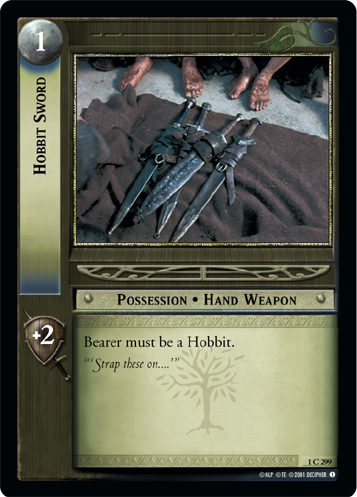 , some version of Sting (1R313)
, some version of Sting (1R313)
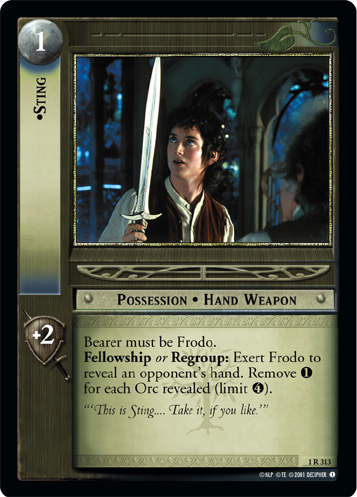 , A Promise (2R112)
, A Promise (2R112)
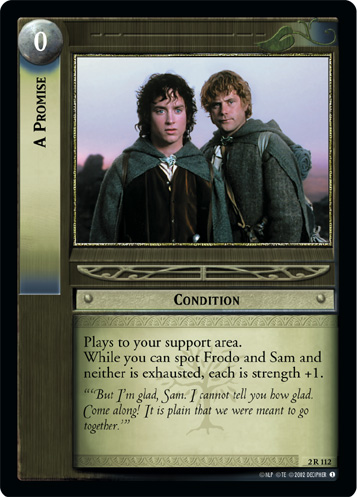 , or O Elbereth! Gilthoniel! (2R108)
, or O Elbereth! Gilthoniel! (2R108)
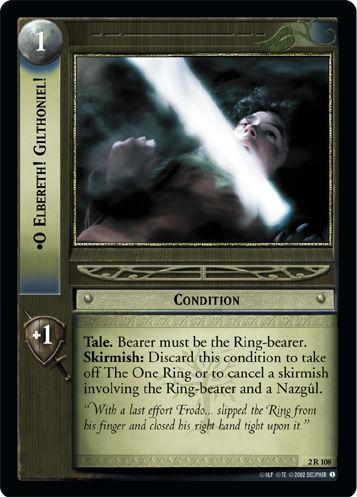 . You can also pump his strength temporarily, especially with Merry, Friend to Sam (1R302)
. You can also pump his strength temporarily, especially with Merry, Friend to Sam (1R302)
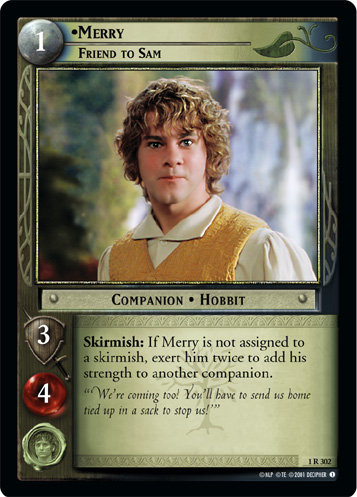 , Boromir, Son of Denethor (1U97)
, Boromir, Son of Denethor (1U97)
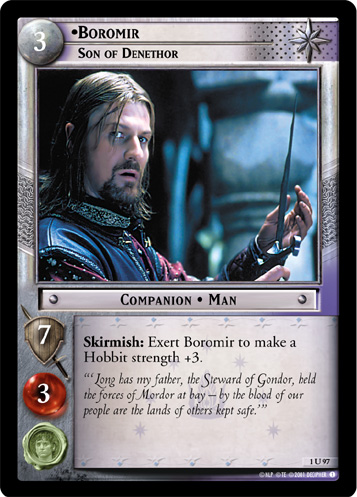 , or Hobbit Intuition (1C296)
, or Hobbit Intuition (1C296)
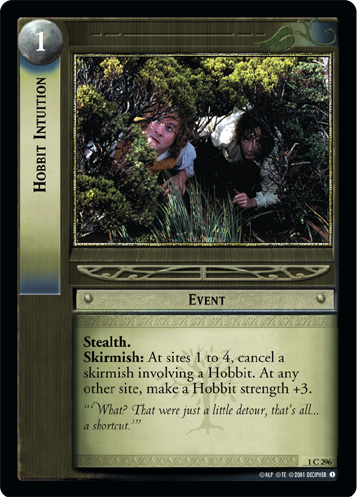 . You can protect him from being overwhelmed, with cards like Bounder (1C286)
. You can protect him from being overwhelmed, with cards like Bounder (1C286)
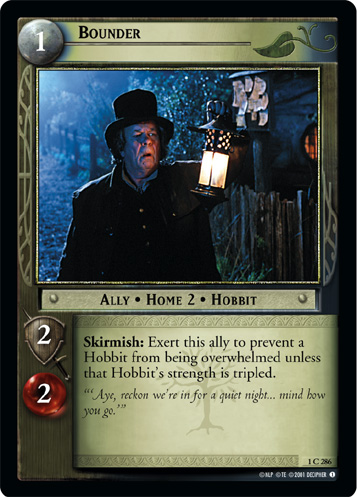 or The Tale of the Great Ring (10U116)
or The Tale of the Great Ring (10U116)
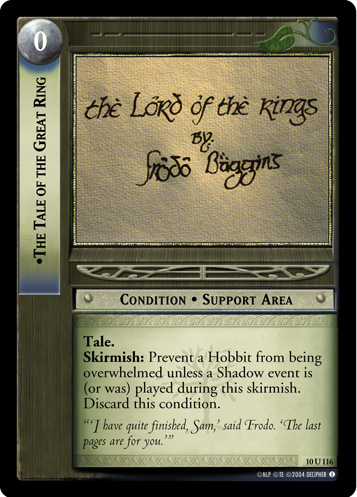 . Or, in early formats like Fellowship Block and Towers Standard, you can simply cancel his skirmish, with cards like Hobbit Stealth (1C298)
. Or, in early formats like Fellowship Block and Towers Standard, you can simply cancel his skirmish, with cards like Hobbit Stealth (1C298)
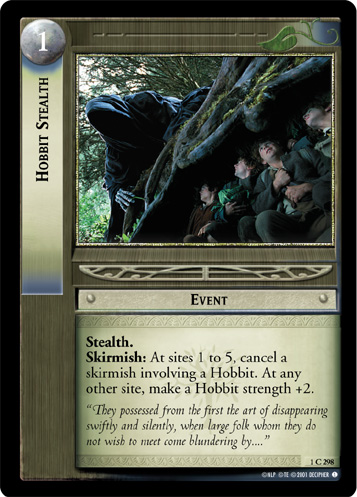 , O Elbereth! Gilthoniel! (2R108)
, O Elbereth! Gilthoniel! (2R108)
 , Filibert Bolger, Wily Rascal (2C101)
, Filibert Bolger, Wily Rascal (2C101)
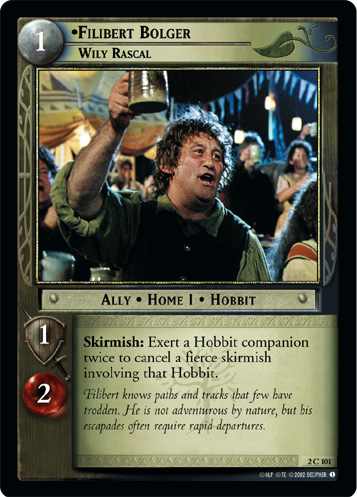 , or Frodo's Cloak (4R303)
, or Frodo's Cloak (4R303)
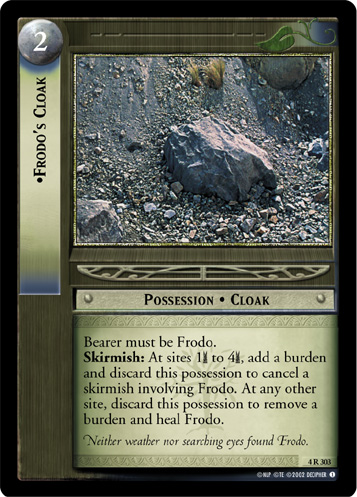 .
.
Frodo has three different roles in three different periods of the game. For the first eight sets, you have to play him, but you can cancel his skirmishes. There's no way around it in Fellowship Block, Towers Standard, Towers Block, or King Standard: you have to find a way to protect Frodo.
Versions of Frodo[edit]
| Portrait |
Name |
Game Text
|
|
|
Frodo, Old Bilbo's Heir (1R289)
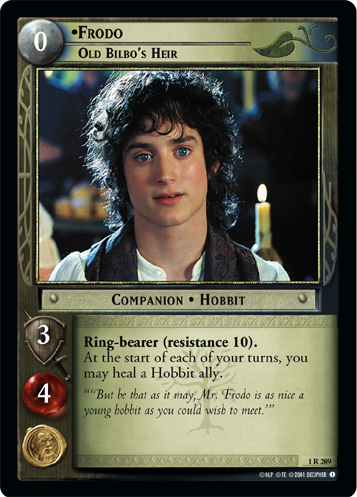
|
Ring-bearer (resistance 10).
At the start of each of your turns, you may heal a Hobbit ally.
|
|
|
Frodo, Son of Drogo (1C290)
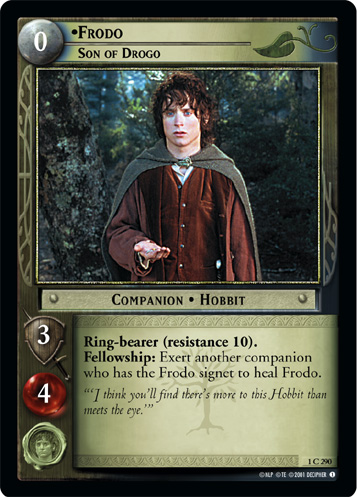
|
Ring-bearer (resistance 10).
Fellowship: Exert another companion who has the Frodo signet to heal Frodo.
|
|
|
Frodo, Reluctant Adventurer (2C102)
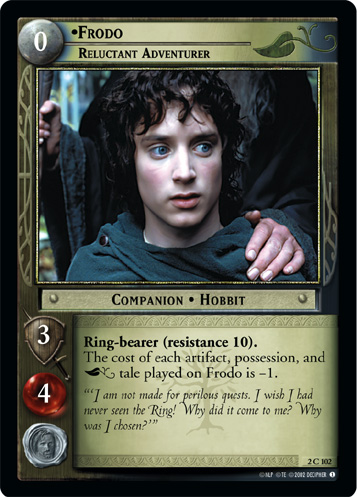
|
Ring-bound. Ring-bearer (resistance 10).
The cost of each artifact, possession, and  tale played on Frodo is -1. tale played on Frodo is -1.
|
|
|
Frodo, Courteous Halfling (4R301)
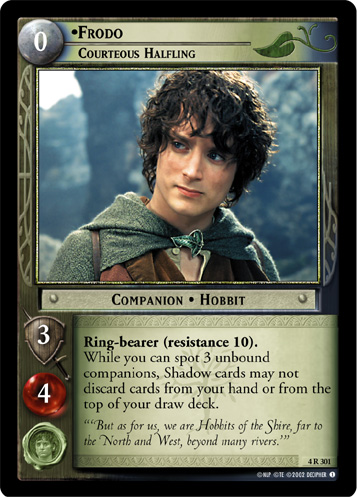
|
Ring-bearer (resistance 10).
While you can spot 3 unbound companions, Shadow cards may not discard cards from your hand or from the top of your draw deck.
|
|
|
Frodo, Tired Traveller (4C302)
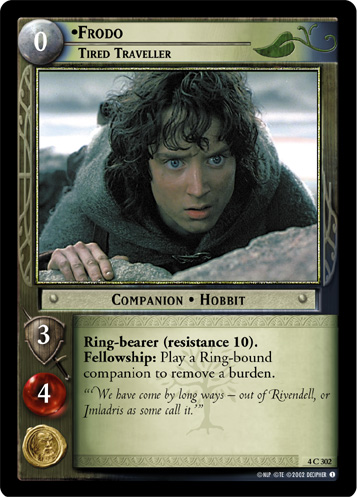
|
Ring-bearer (resistance 10).
Fellowship: Play a Ring-bound companion to remove a burden.
|
|
|
Frodo, Master of the Precious (5U111)
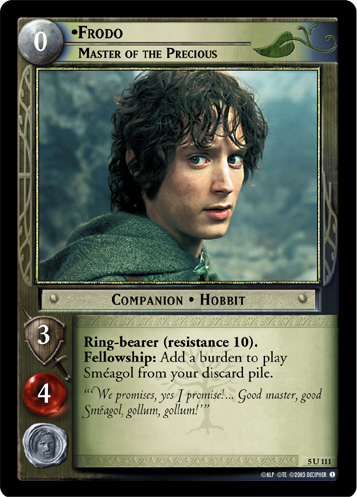
|
Ring-bearer (resistance 10).
Fellowship: Add a burden to play Sméagol from your discard pile.
|
|
|
Frodo, Hope of Free Peoples (7C317)
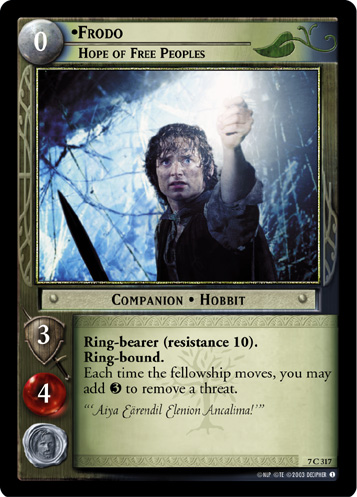
|
Ring-bearer (resistance 10).
Ring-bound.
Each time the fellowship moves, you may add  to remove a threat. to remove a threat.
|
|
|
Frodo, Wicked Masster! (7R318)
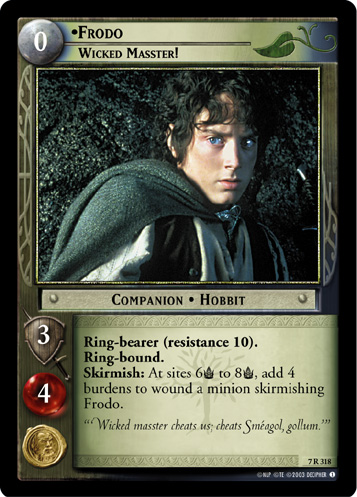
|
Ring-bearer (resistance 10).
Ring-bound.
Skirmish: At sites 6 to 8 to 8 , add 4 burdens to wound a minion skirmishing Frodo. , add 4 burdens to wound a minion skirmishing Frodo.
|
|
|
Frodo, Resolute Hobbit (10P121)
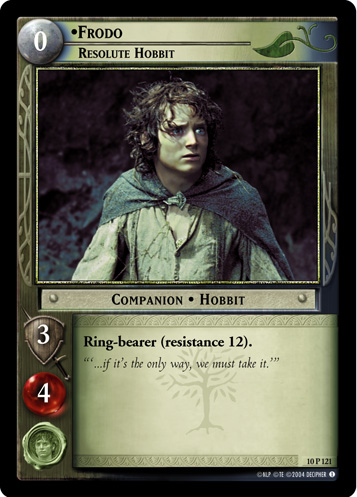
|
Ring-bearer (resistance 12).
|
|
|
Frodo, Protected by Many (11S164)
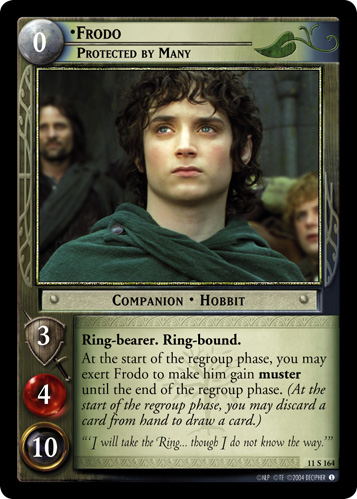
|
Ring-bearer. Ring-bound. At the start of the regroup phase, you may exert Frodo to make him gain muster until the end of the regroup phase. (At the start of the regroup phase, you may discard a card from hand to draw a card.)
|
|
|
Frodo, Frenzied Fighter (13R149)

|
Ring-bound.
While you can spot more minions than companions, Frodo cannot be overwhelmed unless his strength is tripled.
Skirmish: If Frodo is not assigned to a skirmish, exert Frodo to have him replace a Ring-bound companion skirmishing a minion.
|
|
|
Frodo, Weary From the Journey (15C144)
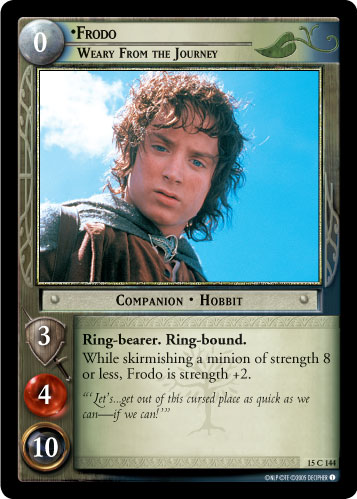
|
Ring-bearer. Ring-bound.
While skirmishing a minion of strength 8 or less, Frodo is strength +2.
|
|
|
Frodo, Little Master (19P28)
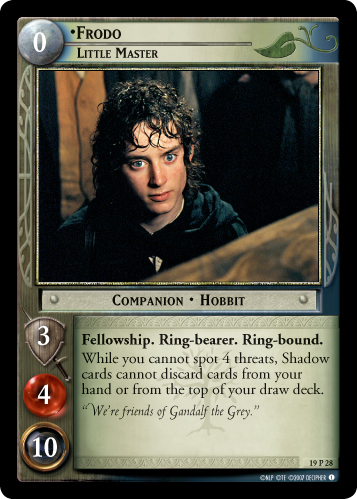
|
Fellowship. Ring-bearer. Ring-bound.
While you cannot spot 4 threats, Shadow cards cannot discard cards from your hand or from the top of your draw deck.
|
|
|
Frodo, Mr. Underhill (0P67)
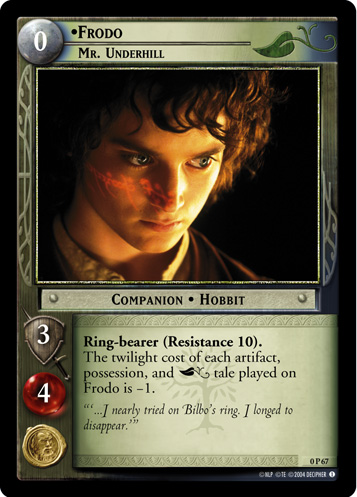
|
Ring-bound. Ring-bearer (resistance 10).
The cost of each artifact, possession, and  tale played on Frodo is -1. tale played on Frodo is -1.
|
|
|
Frodo, Mr. Underhill (0W25)
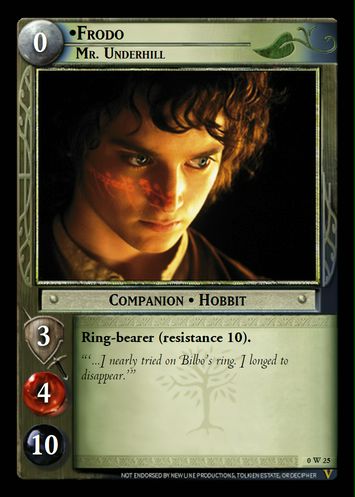
|
Ring-bearer.
|
Cards which mention Frodo by name[edit]
to-do
See Also[edit]
 , he's always your ring-bearer if he's in your deck, and thus costs zero twilight. Until Reflections, he was the only possible ring-bearer at the start of the game, and (along with Sam) was one of only two characters with a resistance score.
, he's always your ring-bearer if he's in your deck, and thus costs zero twilight. Until Reflections, he was the only possible ring-bearer at the start of the game, and (along with Sam) was one of only two characters with a resistance score.
 , some version of Sting (1R313)
, some version of Sting (1R313)
 , A Promise (2R112)
, A Promise (2R112)
 , or O Elbereth! Gilthoniel! (2R108)
, or O Elbereth! Gilthoniel! (2R108)
 . You can also pump his strength temporarily, especially with Merry, Friend to Sam (1R302)
. You can also pump his strength temporarily, especially with Merry, Friend to Sam (1R302)
 , Boromir, Son of Denethor (1U97)
, Boromir, Son of Denethor (1U97)
 , or Hobbit Intuition (1C296)
, or Hobbit Intuition (1C296)
 . You can protect him from being overwhelmed, with cards like Bounder (1C286)
. You can protect him from being overwhelmed, with cards like Bounder (1C286)
 or The Tale of the Great Ring (10U116)
or The Tale of the Great Ring (10U116)
 . Or, in early formats like Fellowship Block and Towers Standard, you can simply cancel his skirmish, with cards like Hobbit Stealth (1C298)
. Or, in early formats like Fellowship Block and Towers Standard, you can simply cancel his skirmish, with cards like Hobbit Stealth (1C298)
 , O Elbereth! Gilthoniel! (2R108)
, O Elbereth! Gilthoniel! (2R108)
 , Filibert Bolger, Wily Rascal (2C101)
, Filibert Bolger, Wily Rascal (2C101)
 , or Frodo's Cloak (4R303)
, or Frodo's Cloak (4R303)
 .
.















